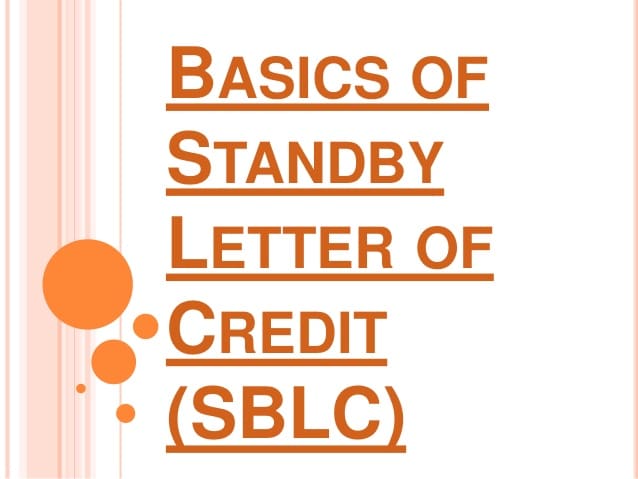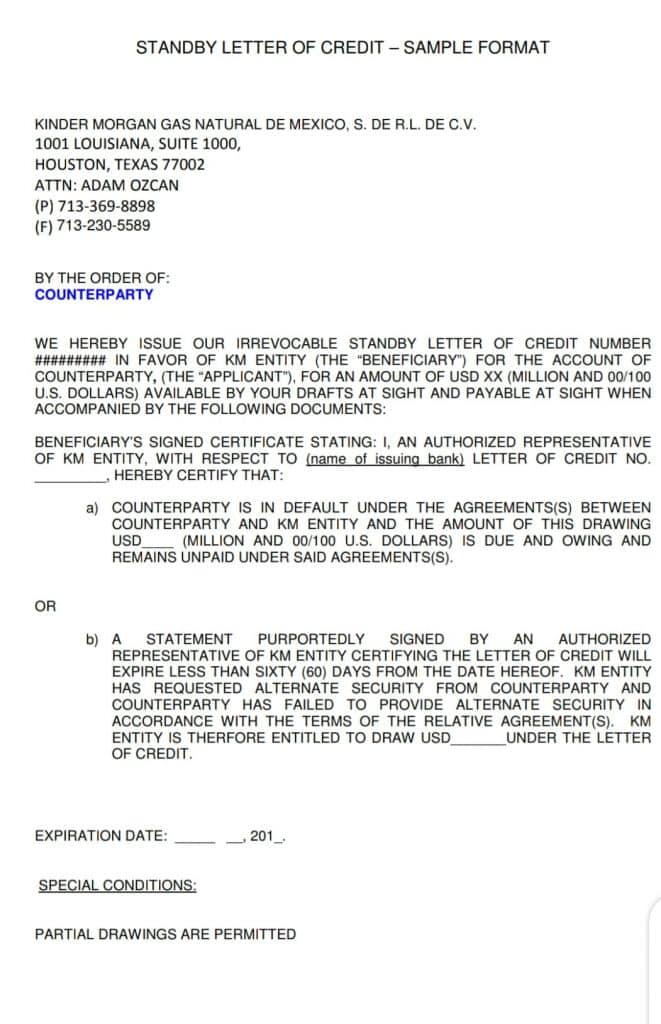Imagine a company involved in international trade that wants to sell a commodity to a buyer who they don’t know in person. What assurance do they have that the buyer will pay when the product is sent to him? Or what will be their fate if the supposed buyer decides to abscond with their product. This is why most seller demands a standby letter of credit. Hence hedging out the risk involved to a bank that will guarantee to pay if the buyer defaults or breach the agreement. This article will serve as a guide in showing the reader what is standby, and irrevocable standby letter of credit. It will also cover examples and samples of a standby letter of credit. Not leaving behind the difference between standby letter of credit vs letter of credit.

Relax, enjoy and learn.
Keep reading!!!
Let’s continue, shall we?
What Is Standby Letter Of Credit?
A standby letter of credit(SBLC) is a legal document where a bank promises the payment of a particular amount of money to a seller if the buyer breaches the agreement.
However, a standby letter of credit helps promote international trade between companies that don’t know each other and have diverse laws and regulations. Indeed, the buyer is sure to receive the goods likewise the seller assured of his payment. However, a SLOC doesn’t guarantee the buyer will be comfortable with the product.
Nevertheless, an SBLC serves as a protection for the payment of a shipment of physical goods or completed service to the seller. In the event, an unexpected circumstance prevents the buyer from making the scheduled payments to the seller. In such a case, the SBLC guarantees the needed payments are made to the seller after the realization of the required obligations.
How Does A SBLC Works?
A SLOC is usually employed by a business to help it get a contract. The contract is a “standby” agreement because the bank will have to pay only in a worst-case scenario. Truly, an SBLC guarantees payment to a seller, however, the agreement must be followed precisely. For example, a delay in shipping or a misspelling of a company’s name can lead to the bank declining to make the payment.
Additionally, since the people involved do not know each other, the letter ensures the seller’s confidence in the transaction. It is a sign of good faith. Hence, it shows the buyer’s ability to make payments for goods or services even if an unexpected event occurs.
How Do You Get a SBLC?
The means of getting an SBLC are alike to a loan application process. The process begins when the buyer applies for an SBLC at a commercial bank. The bank will conduct its due diligence on the buyer to evaluate its credit score, based on past credit history and the most recent credit report.
If the buyer’s credit score is not worth it, the bank may demand an asset or the funds on deposit as collateral from the buyer before approval. However, the risk involved, the depth of the business, and the amount secured by the SBLC will determine the level of collateral.

Afterward, the buyer will also be asked to provide the bank with information about the seller, shipping documents required for payment, the beneficiary’s bank, and the period when the SBLC is valid.
Subsequently, after an evaluation of the documentation, the commercial bank will provide an SBLC to the buyer. Further, the bank will impose a service fee of 1% to 10% for each year when the financial document remains valid. However, if the buyer meets its requirements in the contract before the due date, the bank will end the SBLC without a further charge to the buyer.
Finally, if the buyer fails to fulfill his agreement due to several reasons, such as bankruptcy, dishonesty, etc. The buyer’s bank expects the seller to provide all the required documentation listed in the SBLC within a specified period. Then the bank will make the payment due to the seller’s bank.
Now, let us discuss briefly some examples of a standby letter of credit.
Standby Letter Of Credit Example
This is a typical example of a standby letter of credit.
For example, Mr. josh who resides in the US agrees to purchase 9000 pairs of sandals from Mr. Janv who resides in China. However, Mr. Janv prefers to avoid the risk, hence, he asks Mr. josh to get a standby letter of credit. Mr. josh obtains a standby letter of credit from WNE bank and he includes the following clauses –
- The material of the socks should be – 60% leather 40% rubber
- Each pair should be packaged in clear white nylon with a branded name.
- There can be only a 2% defect margin i.e. only two pairs of defective sandals in a hundred pairs is acceptable.
Mr. Janv should fulfill all the above-mentioned performance criteria to be eligible for payment through a standby letter of credit.
Standby Letter Of Credit Sample
The sample of the standby letter of credit is in the image below. Do well to click.

Standby Letter Of Credit vs Letter Of Credit
A standby letter of credit is similar and sometimes confused with the normal letter of credit. However, there are some distinct characteristics within them. Let’s take a look at some of these differences between standby letter of credit vs letter of credit.
Features
A letter of credit does not have any precise clauses that the buyer must obey for the completion of a transaction. It does have basic obligations such as documentation, packing, etc. Indeed, it’s the most basic payment instrument.
However, a standby letter of credit may have explicit conditions that the buyer must meet so he can use this instrument. Like the example given above, a regular letter of credit cannot have such enforcement rules.
The Requirement Of Issuing Bank
When issuing a letter of credit the bank reviews the buyer’s reliability and credit record. Additionally, it is usually the scenario that a buyer asks his banker for a letter of credit, i.e. the buyer is usually dealing with the said bank for a long time. Hence, the letters of credit are generally unsecured.
On the contrary, a standby letter of distinction provides a responsibility to the bank, therefore the bank will demand collateral in the form of protection to issue a standby letter of distinction.
Purpose Of Credit
The goal of a letter of credit is to use it to complete a transaction. It provides protection and assurance to the seller that the buyer will pay for the supply of goods. And this is the approved payment document used for international transactions where often both the parties are unknown to each other.
However, Standby Letter of Credit is a secondary document, used only once the primary document fails. Hence, SLC remains a standby document and used unusually.
Period Of Time Involve
A letter of credit is a short-term instrument. Hence, it is usually valid for 90 days.
On the other hand, a standby letter of credit is a long-term instrument, where it is mostly value for one year or more.
Now, let us deviate a little by discussing irrevocable letter of credit.
Irrevocable Letter Of Credit (ILOC)
An irrevocable letter of credit (ILOC) is an official letter from a bank that ensures payment for goods or services being purchased by the individual or entity (applicant) that requests the letter of credit from an issuing bank.
However, an irrevocable letter of credit cannot be withdrawn, nor in any way adjusted, except with the clear agreement of all parties involved: the buyer, the seller, and the issuing bank. For example, the seller does not have the right by himself to change any of the terms of an ILOC once it is issued.
Although an ILOC is irrevocable while it is valid, usually the time period during which a proposed transaction is required to be concluded, an ILOC terminates at a specified point in time, which is noted in the letter of credit.
Indeed, ILOCs can either be confirmed or unconfirmed. A confirmed ILOC offers a guarantee of payment from both the buyer’s bank and the seller’s bank. Hence, it provides extra risk security for the seller.
In contrast, in an unconfirmed ILOC, the seller’s bank has no obligation for payment and typically serves only as a mediator to transfer payment to the seller from the buyer’s bank.
Sample of Irrevocable Standby Letter Of Credit (ILOC)
Here is a sample of a irrevocable standby letter of credit.
Issuing Bank
Texas, USA
Seller
City, Country
Dear Sirs,
We hereby issue our irrevocable standby letter of credit no. …, by order of Josh Limited, Texas, USA, for an amount of $2,000,000.00 (Dollar, two million 00/100) which expires at our counters on 30 November 20xx.
This standby letter of credit is available with WNE Bank, Texas by payment upon presentation of the following documents:
- Beneficiary’s certificate stating that goods have been shipped and that the required documents have been sent to Buyers Limited and have not been paid on due date
- Copy of unpaid invoice
- Copy of transport document
Partial drawings are allowed.
All charges outside the United State of America under this standby letter of credit are for the account of the beneficiary/applicant.
Upon receipt of credit complying documents we shall cover you as per your instructions.
Except where otherwise expressly stated, this standby letter of credit is subject to the Uniform Customs and Practice for Documentary Credits (2007 Revision) ICC Publication No. 600.
Please quote our reference number on any correspondence.
Yours truly,
Issuing bank
Conclusion
In conclusion, a standby letter of credit vs letter of credit and its example are very vital when dealing with business transactions.
FAQ Questions
What does standby mean in letter of credit?
The contract is a “standby” agreement because the bank will have to pay only in a worst-case scenario. Truly, an SBLC guarantees payment to a seller, however, the agreement must be followed precisely.
What is the difference between a letter of credit and a standby letter of credit?
A standby letter of credit is similar and sometimes confused with the normal letter of credit. However, there are some distinct characteristics within them. Let’s take a look at some of these differences between standby letter of credit vs letter of credit.
Related Article






